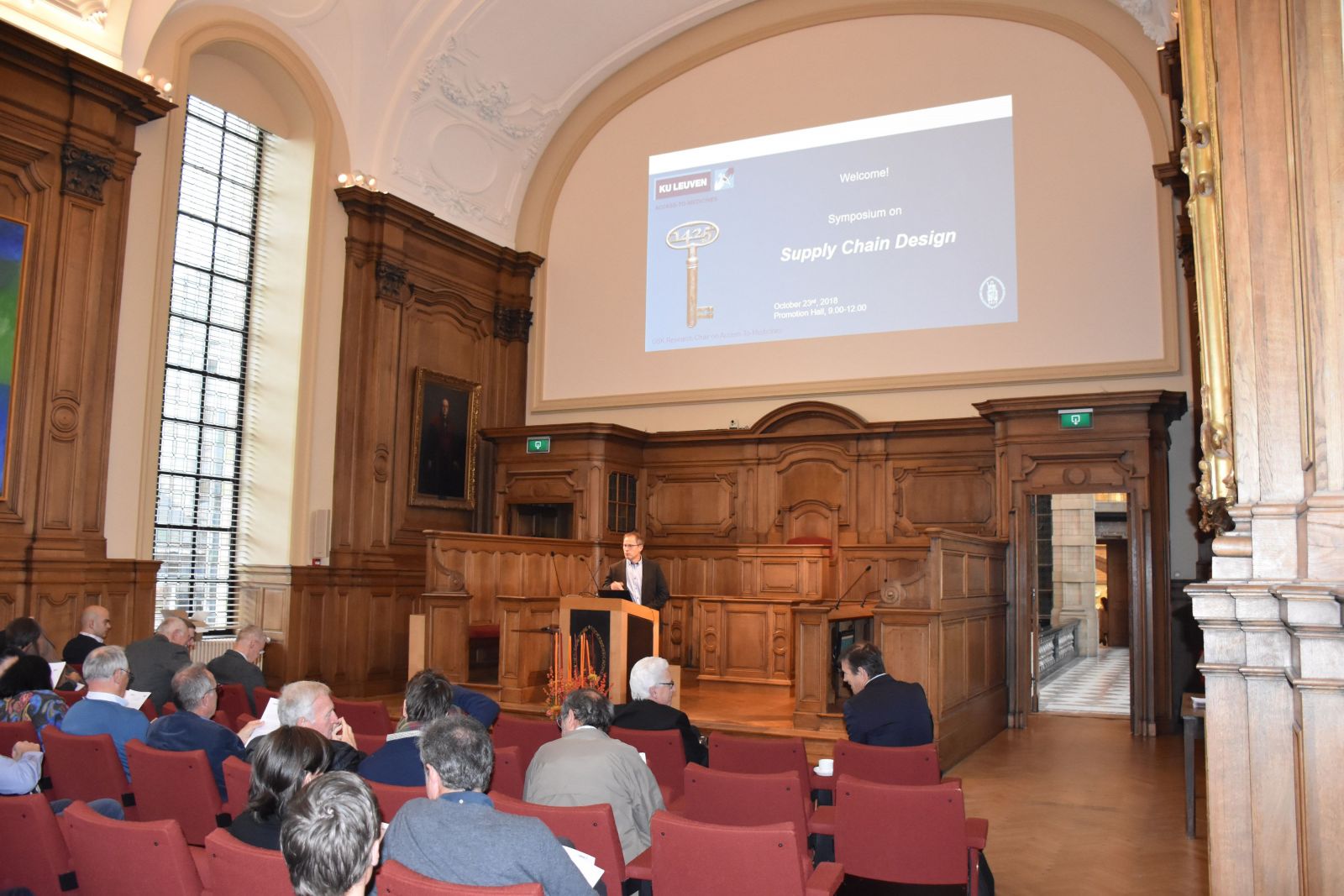P&L
Pushing the Boundaries of Supply Chain Design
On October 23rd, on the occasion of the public doctoral defense of Stef Lemmens, the Research Center for Operations Management organized a symposium on supply chain design. At this symposium, several international researchers from MIT Sloan School of Management, INSEAD, Politecnico di Milano and KU Leuven shared their findings on supply chain design for different industrial applications. These applications include vaccine, humanitarian, closed-loop, distributed manufacturing and additive manufacturing supply chains.

Nowadays, Supply Chain Design is breaking out of the modeler’s and analyst’s room. Supply chains are interacting in a complex world and therefore new supply chain design options, as well as significant supply chain changes, can only be accepted and effective if they are anchored and supported by all the stakeholders involved. Such needs require to push the boundaries of the traditional models on supply chain design.
END-TO-END VACCINE SUPPLY CHAIN DESIGN
First, Prof. Dr. Nico Vandaele (KU Leuven) emphasized the challenges of end-to-end vaccine supply chain design. Designing such supply chains requires innovative methods to take a broader base of stakeholders and their conflicting objectives into account. Given a group of stakeholders, many of their expectations are not only related to maximizing profits or minimizing costs, but they are also related to sustainability, humanity and cooperation too. In this talk, a stakeholder-based framework for supply chain design is introduced. This framework is not only able to take the stakeholder preferences into account, but it also proposes a methodology to evaluate and compare real-life scenarios (stemming from the stake holders) according to multiple criteria of different kinds.
COORDINATION IN SUPPLY CHAIN DESIGN
Second, Prof. Dr. Stephen Graves (MIT Sloan School of Management) elaborated on the traditional guaranteed service model as a pragmatic approach to minimize a single company’s inventories. In his talk, he demonstrated how two companies in need for coordination (each operating under the guaranteed service model) can design a contract to reach a globally optimal solution to minimize the entire supply chain’s inventories. Furthermore, it is shown that such a solution is typically accepted by both companies.
THE DESIGN OF CLOSED-LOOP SUPPLY CHAINS
Third, Prof. Dr. Luk Van Wassenhove (INSEAD) presented his critical view on closed-loop supply chains and circular economy. He postulated the relevance of closed-loop supply chains in modern times, but emphasized that the effort to make closed-loop supply chain systems work is often under estimated. Although many papers are produced about these subjects, there are still some important obstacles which prevent the development of successful circular economy business models, such as (1) the customer preferences related to buy, lease and pay for use decisions, (2) the uncertainty related to legislation and (dis)economies of scale and (3) the complexity of the tools to evaluate circular economy business models.
THE DESIGN OF DISTRIBUTED MANUFACTURING SUPPLY CHAINS IN DEVELOPING COUNTRIES
Fourth, Prof. Dr. Andre Calmon (INSEAD) showed the virtualor “cloud” factory which is employed by SOKO. The company relies on the flexibility of artisans in Kenya to enable fast high-quality jewelry products. The postulated research question is novel and challenging as it involves the trade-off between SOKO’s profitability and the investment in its social mission by training artisans and thus building a strong capacity base.
ADDITIVE MANUFACTURING SUPPLY CHAIN DESIGN
Finally, Prof. Dr. Andrea Matta (Politecnico di Milano) highlighted the growing interest of additive manufacturing toward different industries such as healthcare and aero nautics. Typically, additive manufacturing is perceived as an attractive technology because it enables the production of highly complex products and reduces the need for high-volume safety stocks. However, the required knowledge, long processing times and high investments cost may form significant barriers. In this talk, a modeling approach is proposed to extract for which cases additive manufacturing and conventional manufacturing fit the requirements best.
These five talks led to interesting discussions during the break and after the symposium. We thank all the speakers and participants for their contribution to a successful and inspiring event.
Stef Lemmens
Nico Vandaele
for contact: stef.lemmens@kuleuven.be and nico.vandaele@kuleuven.be
EREDOCTORAAT
PROF. MARNIK DEKIMPE
Op 24 oktober ontving Prof. Marnik Dekimpe aan de universiteit van Hamburg een eredoctoraat voor zijn wetenschappelijk oeuvre. Hij werd deze eer toegekend omwille van zijn impressionante onderzoeksbijdragen in marketing. Prof. Dekimpe is een voortrekker in het domein van dynamic marketing effects en retailing. Hij publiceerde meer dan 65 internationale academische artikels, maar ook boekbijdragen, conferentiebijdragen en meer. Veel van deze publicaties worden bovendien internationaal erkend als topniveau. Zo heeft hij 19 verschillende best paperawards (winner of finalist) ontvangen en twee life-time contribution awards (Mahajan Award for Lifetime Contributions to Marketing Strategy Research en de Distinguished Scholar Award of the European Marketing Academy). Prof. Dekimpe was ook Editor van het International Journal of Research in Marketing (IJRM), het meest vooraanstaande Europese marketingtijdschrift. Niet in het minst wordt hij ook erkend voor zijn bijdrage aan de opleiding van jonge onderzoekers.
Prof. Dekimpe begeleidde veel doctoraatsstudenten die na hun opleiding belangrijke functies bekleedden. Verder werd Prof. Dekimpe nog eens extra in de bloemetjes gezet voor al zijn inspanningen om Europees marketingonderzoek op de wereldkaart te zetten. Zo heeft hij actief bijgedragen aan de verdere ontwikkeling van de Europese Marketing Academy (EMAC), verzorgde placements van Europese onderzoekers in de Verenigde Staten en zit hij in de board van alle Amerikaanse wetenschappelijke toptijdschriften in marketing.
Hilde Roos en Veerle Van Rompaey
